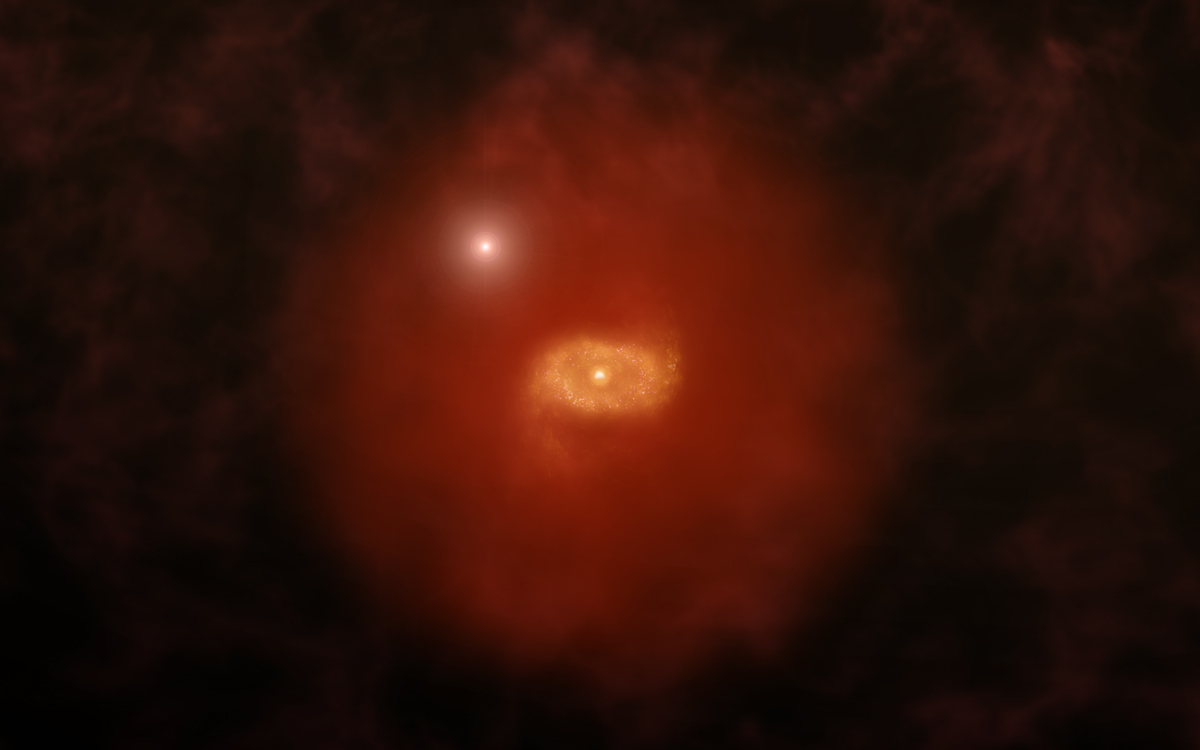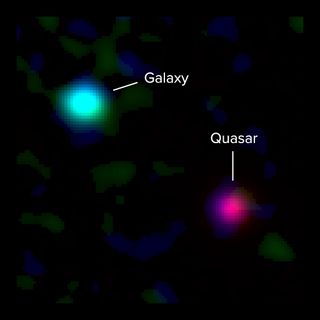Quasars Reveal Early Structure of Milky Way-Like Galaxies

Astronomers are seeing what Earth's own galaxy looked like in its youth by scanning the skies for some of the oldest objects in the universe.
Using the Atacama Large Millimeter/submillimeter Array (ALMA), a large radio observatory in Chile, researchers have taken "baby pictures" of Milky Way-like galaxies when their star formation was just beginning to accelerate. At that time, the universe was nearly two billion years old. Since light moves at a finite speed, looking deep into the universe also means looking back in time, and these young galaxies are about 12 billion light-years away from Earth. The cosmos itself is about 13.8 billion years old.
Looking at two of the ancient galaxies in infrared wavelengths, the researchers saw that very early in the galaxies' development, they had what look like extended discs of hydrogen gas that far outpaced the smaller, star-forming regions within. These galaxies also already had rotating discs of gas and dust, and were forming stars at a relatively rapid pace: up to 100 solar masses (the mass of Earth's sun) per year. [Galactic Evolution: How ;Galaxies are Classified by Type (Infographic)]
Officially designated ALMA J081740.86+135138.2 and ALMA J120110.26+211756.2, the galaxies were observed using light from two quasars in the background. Quasars are supermassive black holes surrounded by bright accretion discs, and are themselves thought to be the centers of particularly active galaxies.

Usually, seeing ordinary galaxies when they are in front of a quasar is difficult, because quasars are blazingly bright and a young galaxy is relatively faint, the researchers said in a statement. But using ALMA, the astronomers were able to see the infrared light from the galaxies' ionized carbon shining on its own, and also hydrogen silhouetted in the shine of the quasars. The carbon, which emits light at a wavelength of 158 micrometers (the far infrared), marked the structure of each galaxy, while emissions of infrared light from dust showed regions where stars were being born, according to the study.
The glowing carbon also offered another clue to the galaxies' structure, because its position was offset from the hydrogen gases that the astronomers initially saw, as revealed by the quasars' shine. That means that the galaxies' gases extend far from the dense carbon regions, suggesting each galaxy has a large halo of hydrogen encircling it, the researchers said.
Looking at the foreground objects that a shining background quasar could reveal, "we had expected we would see faint emissions right on top of the quasar, and instead we saw bright galaxies at large separations from the quasar," J. Xavier Prochaska, an astrophysicist at the University of California, Santa Cruz, and co-author on the new study, said in a statement.
Get the Space.com Newsletter
Breaking space news, the latest updates on rocket launches, skywatching events and more!

The data also showed that the young galaxies have already begun rotating, which is a hallmark of spiral galaxies like the Milky Way, the study said.
The effort to find such early stage galaxies began in 2003, when Prochaska first worked on the idea of using the spectra of quasars, the wavelengths of light they emit, to reveal those of galaxies in the foreground. Such arrangements are called damped Lyman-alpha systems, because the hydrogen gas blocks certain wavelengths of light from the quasar, revealing the gas's presence and extent.
"ALMA has solved a decades-old question on galaxy formation," Chris Carilli, an astronomer with the National Radio Astronomy Observatory in Socorro, New Mexico and a co-author of the new study, said in another statement. "We now know that at least some very early galaxies have halos that are much more extended than previously considered," he said, adding that these halos "may represent the future material for galaxy growth."
The new work was detailed Friday (March 24) in the journal Science.
You can follow us on Twitter at @Spacedotcom. We're also on Facebook & Google+. Original story on Space.com.
Join our Space Forums to keep talking space on the latest missions, night sky and more! And if you have a news tip, correction or comment, let us know at: community@space.com.

Jesse Emspak is a freelance journalist who has contributed to several publications, including Space.com, Scientific American, New Scientist, Smithsonian.com and Undark. He focuses on physics and cool technologies but has been known to write about the odder stories of human health and science as it relates to culture. Jesse has a Master of Arts from the University of California, Berkeley School of Journalism, and a Bachelor of Arts from the University of Rochester. Jesse spent years covering finance and cut his teeth at local newspapers, working local politics and police beats. Jesse likes to stay active and holds a fourth degree black belt in Karate, which just means he now knows how much he has to learn and the importance of good teaching.











